Page 11 of 251
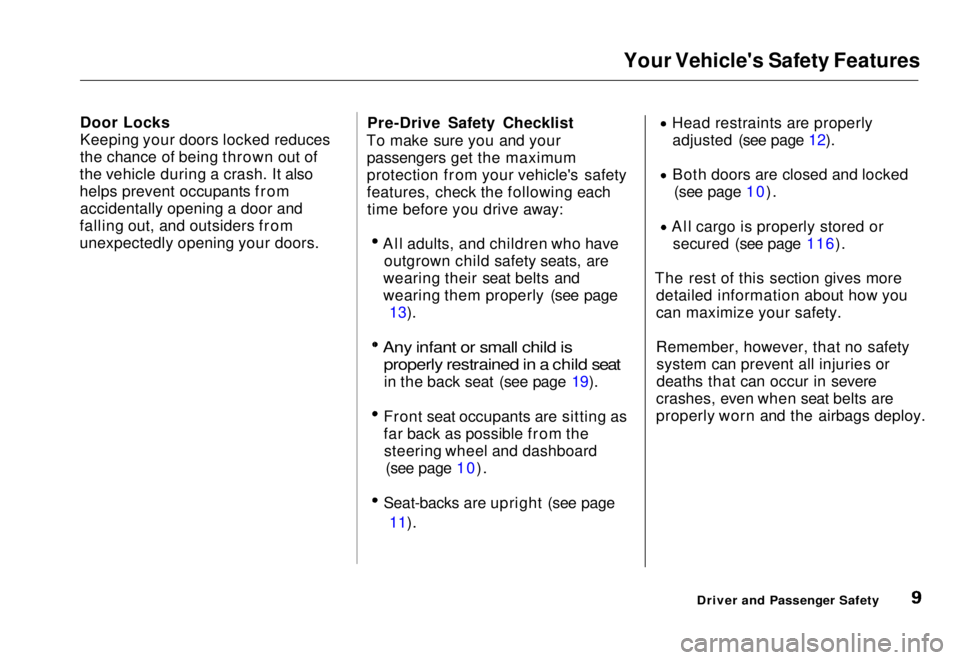
Your Vehicle's Safety Features
Door Locks
Keeping your doors locked reduces
the chance of being thrown out of
the vehicle during a crash. It also
helps prevent occupants from accidentally opening a door and
falling out, and outsiders from
unexpectedly opening your doors. Pre-Drive Safety Checklist
To make sure you and your passengers get the maximum
protection from your vehicle's safety
features, check the following eachtime before you drive away:
All adults, and children who haveoutgrown child safety seats, are
wearing their seat belts and
wearing them properly (see page 13).
Any infant or small child is properly restrained in a child seat
in the back seat (see page 19).
Front seat occupants are sitting as
far back as possible from the steering wheel and dashboard (see page 10). Seat-backs are upright (see page
11). Head restraints are properly
adjusted (see page 12).
Both doors are closed and locked (see page 10). All cargo is properly stored or
secured (see page 116).
The rest of this section gives more detailed information about how you
can maximize your safety.
Remember, however, that no safetysystem can prevent all injuries or
deaths that can occur in severe
crashes, even when seat belts are
properly worn and the airbags deploy.
Driver and Passenger SafetyMain Menu Table of Contents s t
Page 12 of 251
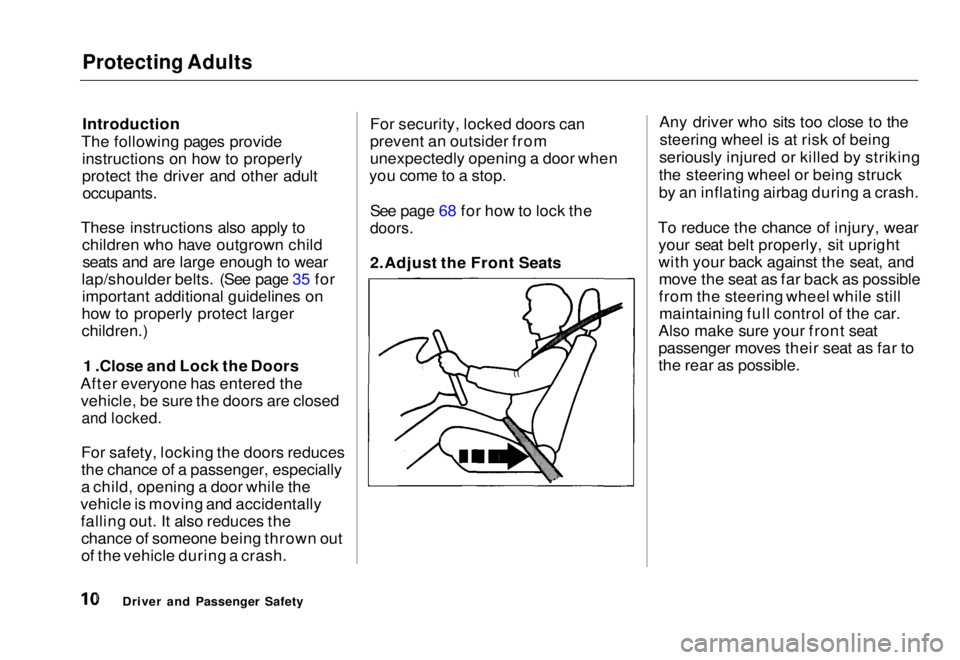
Protecting Adults
Introduction
The following pages provide instructions on how to properly
protect the driver and other adult
occupants.
These instructions also apply to children who have outgrown childseats and are large enough to wear
lap/shoulder belts. (See page 35 for important additional guidelines on
how to properly protect larger
children.)
1 .Close and Lock the Doors
After everyone has entered the vehicle, be sure the doors are closed
and locked.
For safety, locking the doors reduces
the chance of a passenger, especially
a child, opening a door while the
vehicle is moving and accidentally falling out. It also reduces thechance of someone being thrown out
of the vehicle during a crash. For security, locked doors can
prevent an outsider from
unexpectedly opening a door when
you come to a stop.
See page 68 for how to lock the
doors.
2.Adjust the Front Seats Any driver who sits too close to the
steering wheel is at risk of being
seriously injured or killed by striking
the steering wheel or being struck
by an inflating airbag during a crash.
To reduce the chance of injury, wear your seat belt properly, sit upright
with your back against the seat, andmove the seat as far back as possible
from the steering wheel while stillmaintaining full control of the car.
Also make sure your front seat
passenger moves their seat as far to
the rear as possible.
Driver and Passenger SafetyMain Menu Table of Contents s t
Page 15 of 251
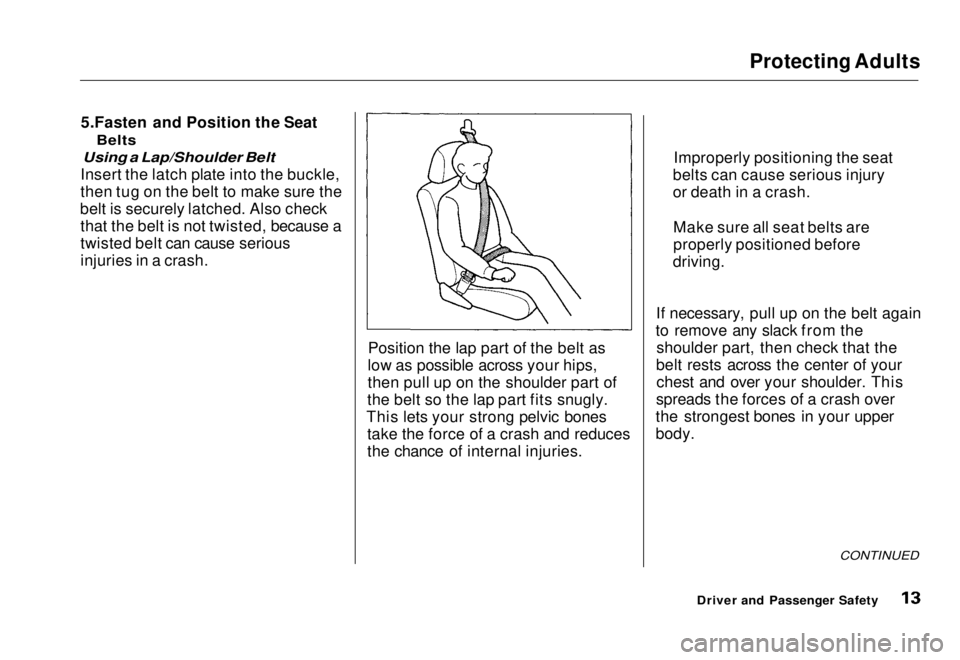
Protecting Adults
5.Fasten and Position the Seat
Belts
Using a Lap/Shoulder Belt
Insert the latch plate into the buckle,
then tug on the belt to make sure the
belt is securely latched. Also check that the belt is not twisted, because a
twisted belt can cause serious
injuries in a crash.
Position the lap part of the belt as
low as possible across your hips,
then pull up on the shoulder part of
the belt so the lap part fits snugly.
This lets your strong pelvic bones take the force of a crash and reduces
the chance of internal injuries. If necessary, pull up on the belt again
to remove any slack from the shoulder part, then check that the
belt rests across the center of your chest and over your shoulder. This
spreads the forces of a crash over
the strongest bones in your upper
body.
CONTINUED
Driver and Passenger Safety
Improperly positioning the seat
belts can cause serious injury
or death in a crash.
Make sure all seat belts are
properly positioned before
driving.Main Menu Table of Contents s t
Page 16 of 251
Protecting Adults
If the seat belt touches or crosses
your neck, or if it crosses your arm instead of your shoulder, you need toadjust the seat belt anchor height.
An improperly positioned seat belt can cause severe neck injuries if the
belt is positioned too high, or serious chest or internal injuries if the belt is
positioned too low. To adjust the height of a front seat
belt anchor, squeeze the two release
buttons and slide the anchor up ordown as needed (it has four
positions).
Never place the shoulder portion of a
lap/shoulder belt under your arm or behind your back. This could cause
very serious injuries in a crash.
Using the Lap Belt
Insert the latch plate into the buckle
marked CENTER. If the belt is too short, hold the latch
plate at a right angle and pull on the
plate to extend the belt. Then insert
the latch plate into the buckle, and
tug on the belt to make sure the belt is securely latched.
Driver and Passenger SafetyMain Menu Table of Contents s t
Page 23 of 251
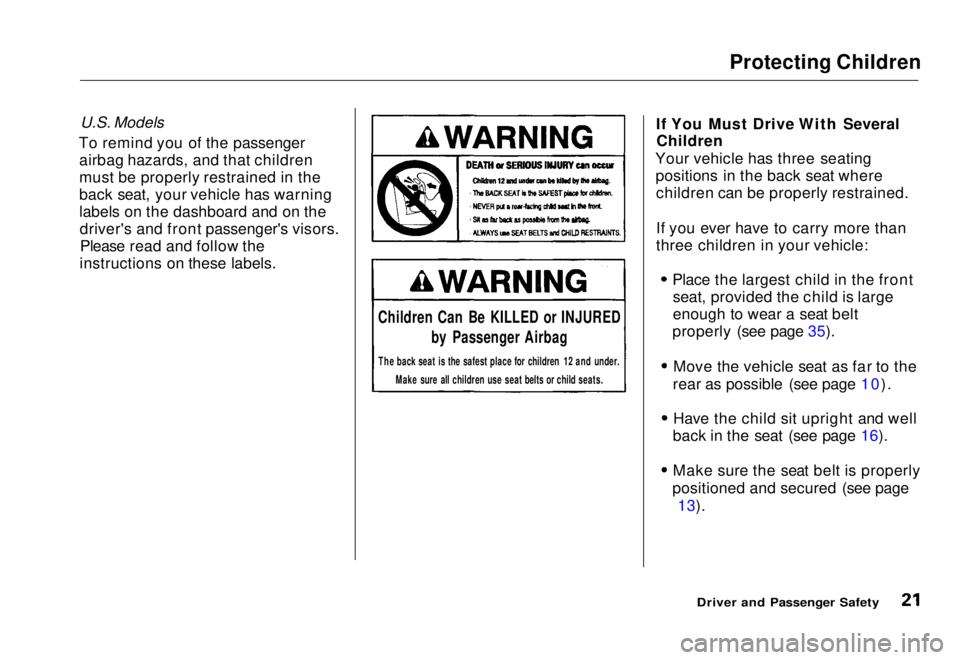
Protecting Children
U.S. Models
To remind you of the passenger airbag hazards, and that children
must be properly restrained in the
back seat, your vehicle has warning
labels on the dashboard and on thedriver's and front passenger's visors.Please read and follow the
instructions on these labels. If You Must Drive With Several
Children
Your vehicle has three seating positions in the back seat wherechildren can be properly restrained.
If you ever have to carry more than
three children in your vehicle:
Place the largest child in the frontseat, provided the child is large
enough to wear a seat belt
properly (see page 35).
Move the vehicle seat as far to the
rear as possible (see page 10).
Have the child sit upright and well
back in the seat (see page 16). Make sure the seat belt is properly
positioned and secured (see page 13).
Driver and Passenger Safety
Children Can Be KILLED or INJURED
by Passenger Airbag
The back seat is the safest place for children 12 and under. Make sure all children use seat belts or child seats.Main Menu Table of Contents s t
Page 27 of 251
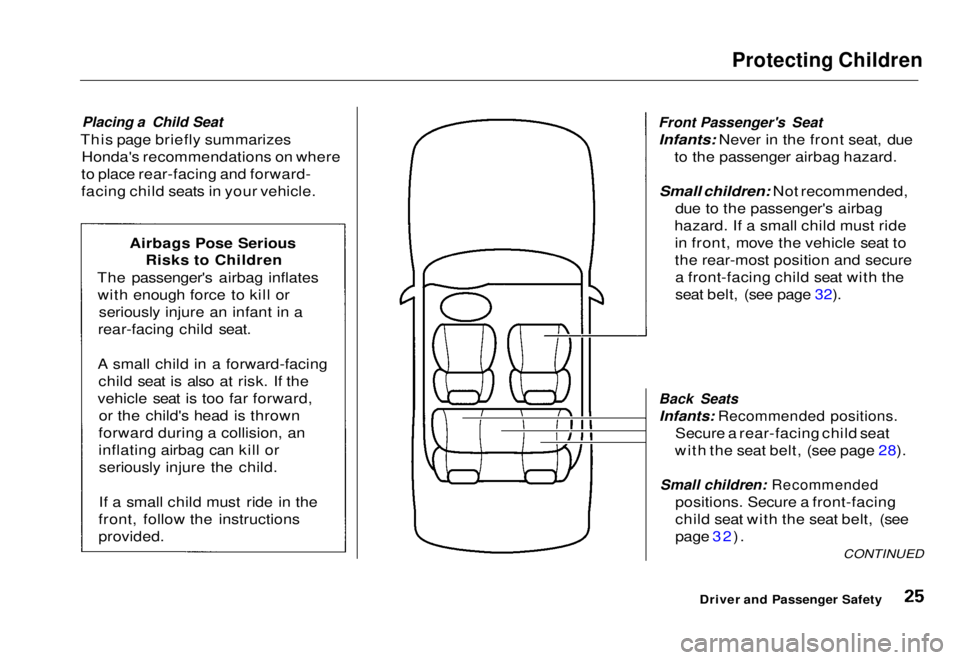
Protecting Children
Placing a Child Seat
This page briefly summarizes Honda's recommendations on where
to place rear-facing and forward-
facing child seats in your vehicle.
Front Passenger's Seat
Infants: Never in the front seat, due to the passenger airbag hazard.
Small children: Not recommended,
due to the passenger's airbag
hazard. If a small child must ride in front, move the vehicle seat to
the rear-most position and securea front-facing child seat with the
seat belt, (see page 32).
Back Seats
Infants: Recommended positions.
Secure a rear-facing child seat
with the seat belt, (see page 28).
Small children: Recommended
positions. Secure a front-facing
child seat with the seat belt, (see
page 32). CONTINUED
Driver and Passenger Safety
Airbags Pose Serious
Risks to Children
The passenger's airbag inflates with enough force to kill or seriously injure an infant in a
rear-facing child seat.
A small child in a forward-facing child seat is also at risk. If the
vehicle seat is too far forward, or the child's head is thrown
forward during a collision, an
inflating airbag can kill or seriously injure the child.
If a small child must ride in the
front, follow the instructions
provided.Main Menu Table of Contents s t
Page 28 of 251
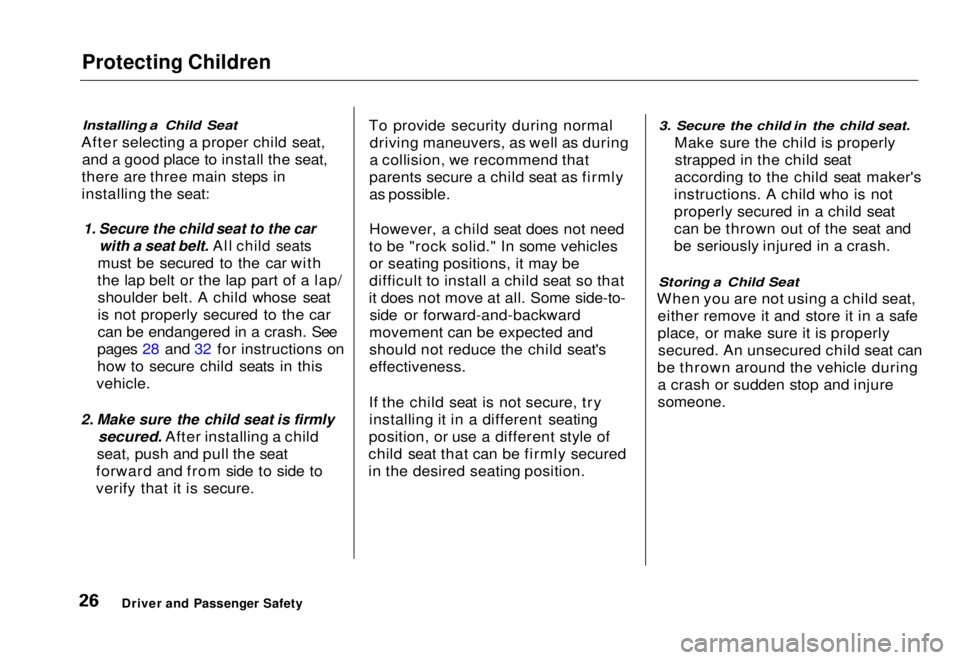
Protecting Children
Installing a Child Seat
After selecting a proper child seat, and a good place to install the seat,
there are three main steps in
installing the seat:
1. Secure the child seat to the car
with a seat belt. All child seats
must be secured to the car with
the lap belt or the lap part of a lap/ shoulder belt. A child whose seat
is not properly secured to the car
can be endangered in a crash. See
pages 28 and 32 for instructions on
how to secure child seats in this
vehicle.
2. Make sure the child seat is firmly
secured. After installing a child
seat, push and pull the seat
forward and from side to side to
verify that it is secure. To provide security during normal
driving maneuvers, as well as during
a collision, we recommend that
parents secure a child seat as firmly
as possible.
However, a child seat does not need
to be "rock solid." In some vehicles or seating positions, it may be
difficult to install a child seat so that
it does not move at all. Some side-to- side or forward-and-backward
movement can be expected and
should not reduce the child seat's
effectiveness.
If the child seat is not secure, try installing it in a different seating
position, or use a different style of
child seat that can be firmly secured
in the desired seating position.
3. Secure the child in the child seat.
Make sure the child is properlystrapped in the child seat
according to the child seat maker's
instructions. A child who is not
properly secured in a child seat
can be thrown out of the seat and
be seriously injured in a crash.
Storing a Child Seat
When you are not using a child seat, either remove it and store it in a safe
place, or make sure it is properlysecured. An unsecured child seat can
be thrown around the vehicle during a crash or sudden stop and injure
someone.
Driver and Passenger SafetyMain Menu Table of Contents s t
Page 30 of 251
Protecting Children
Installing an Infant Seat With a Lap/
Shoulder Belt
The lap/shoulder belts in the outer back seats have a locking
mechanism that must be activated tosecure a child seat.
The following pages provide instructions on how to secure a rear-
facing child seat with this type of seat belt. See page 30 for how to secure a rear-
facing child seat in the center back
seat with the lap belt. See page 30 for
tips on installing an infant seat with either type of seat belt.
1. With the child seat in the desiredback seating position, route the
belt through the child seataccording to the seat maker's
instructions, then insert the latch
plate into the buckle.
Driver and Passenger SafetyMain Menu Table of Contents s t